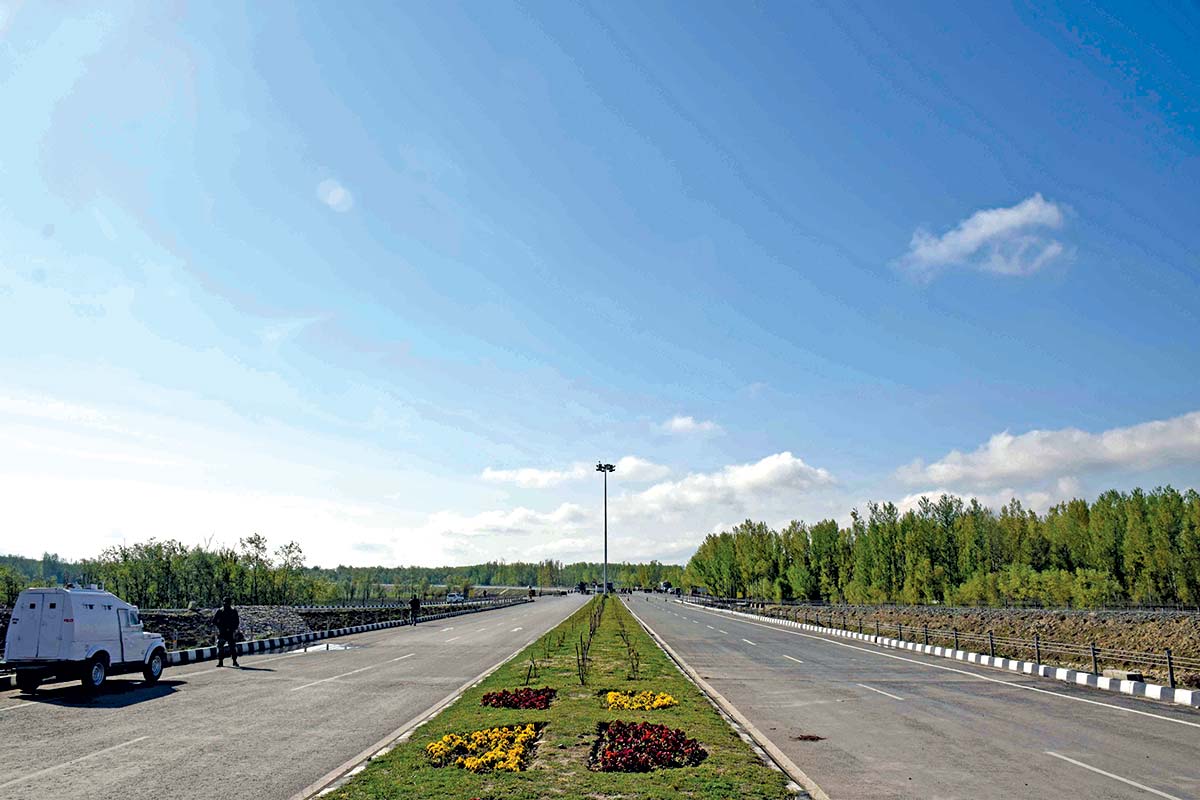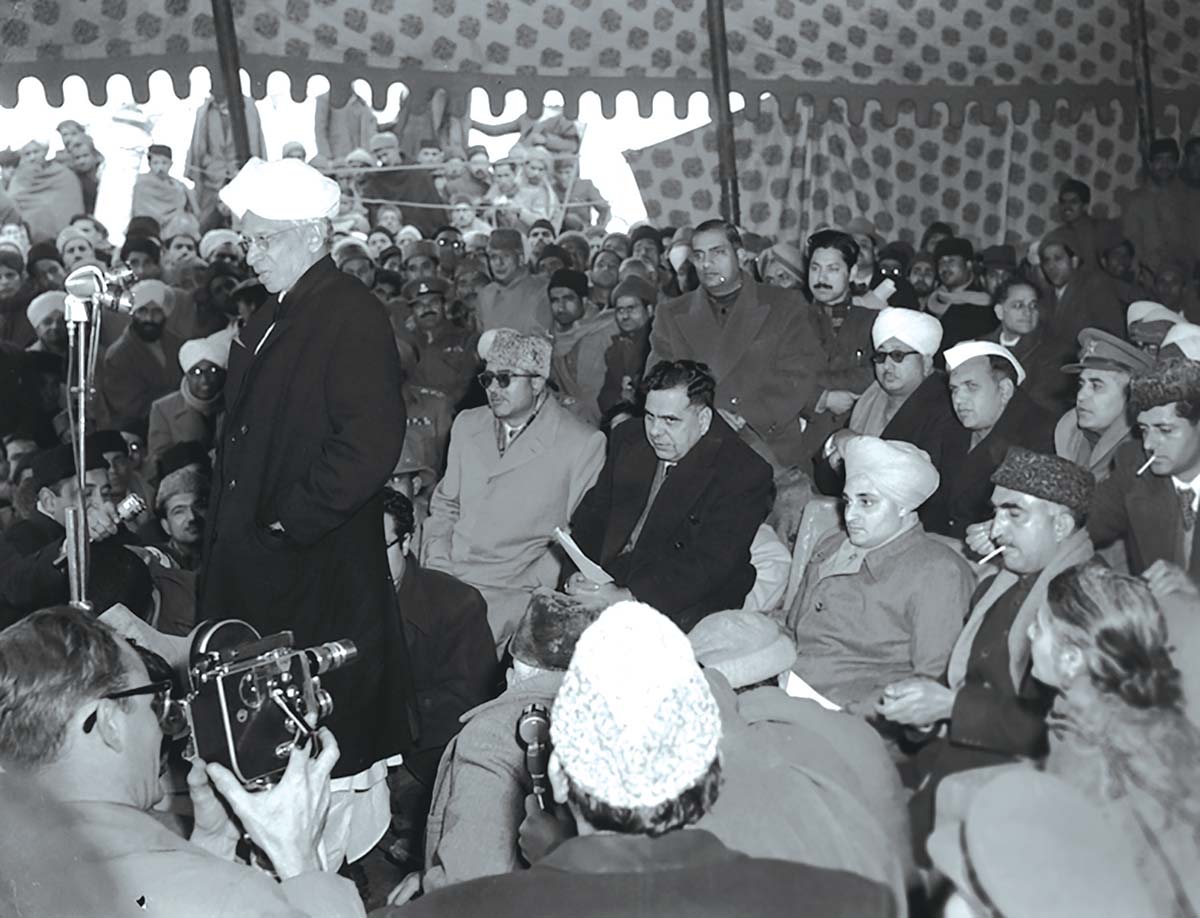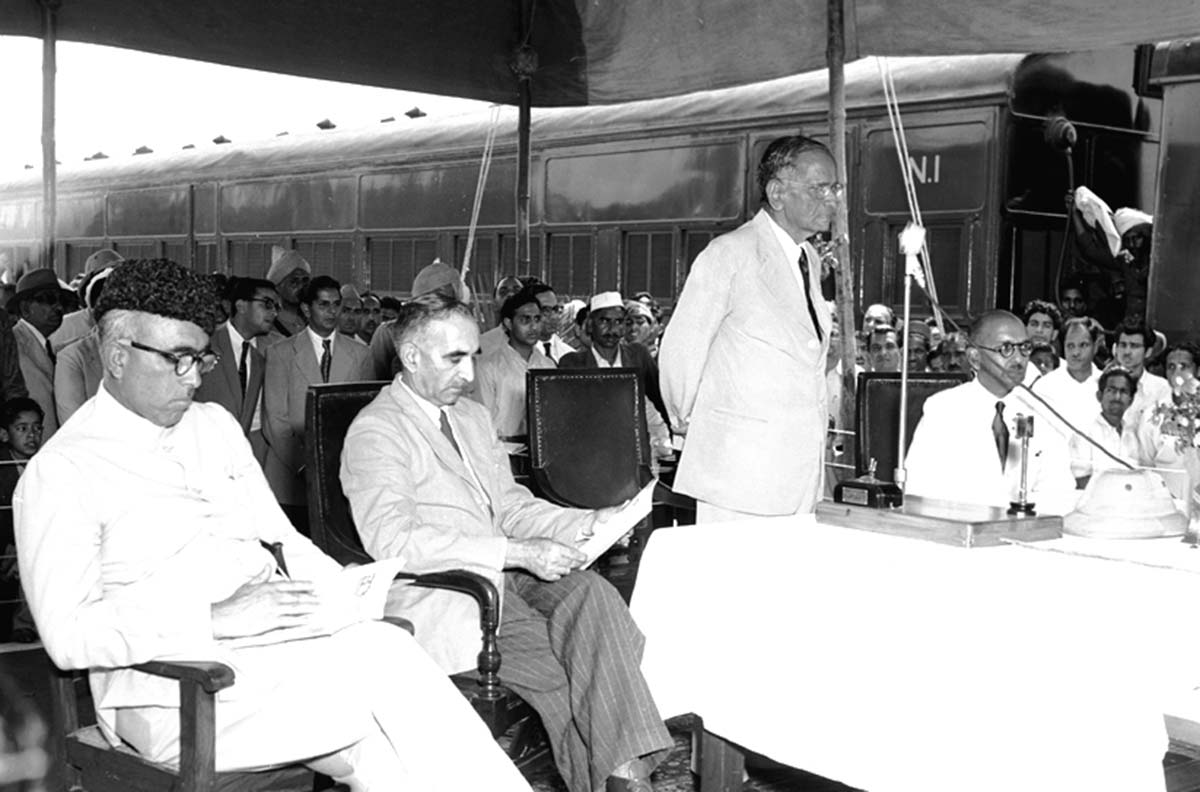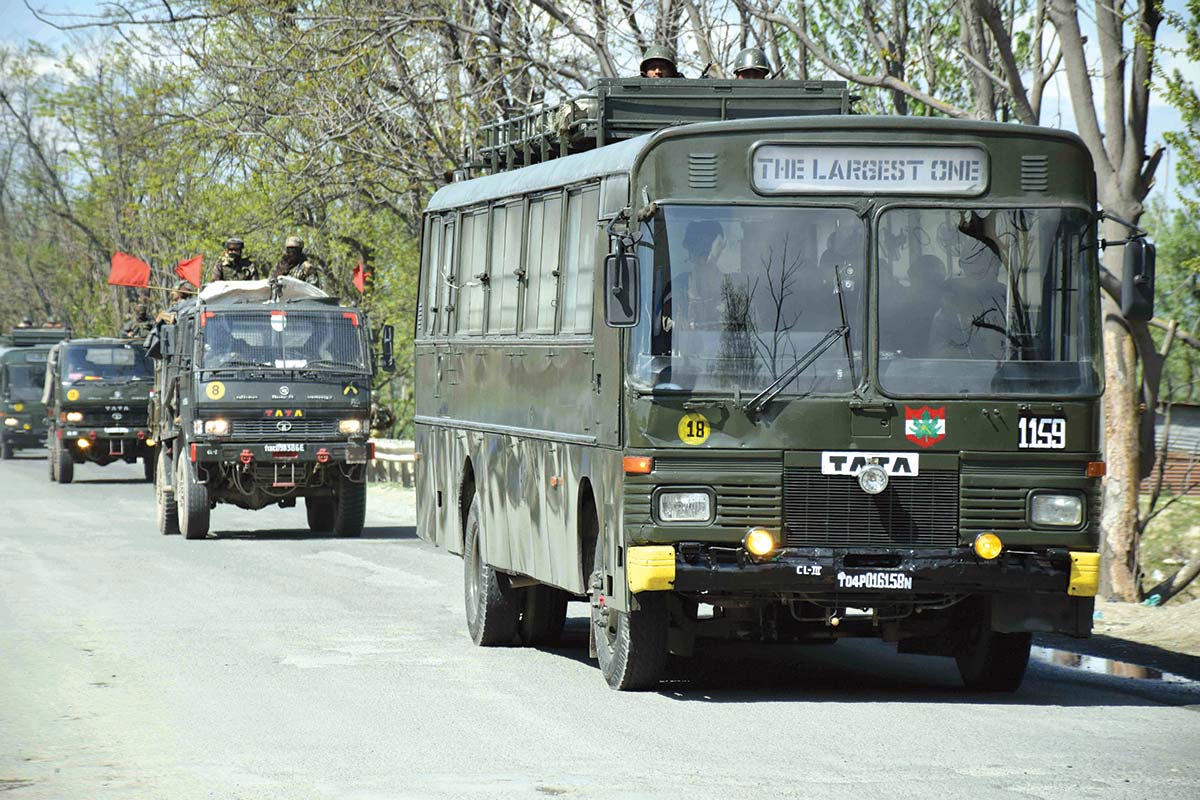In the superfast world, Kashmir’s arterial highway witnessed biweekly halts for the first time after 1922. Earlier, it was for the privileged passage of a family, and now, for the armed forces. While it impacts the trade and routine life, it is adding to Kashmir’s siege mentality further, reports Masood Hussain

On April 10, 2019, on the second day of the biweekly no-go order restricting any non-army movement on the Srinagar-Jammu highway, when a magistrate felt compelled to grant permission to a commuter; he stamped the permission on his hand and signed it. It was valid till his next hand-wash. Expectedly, the photograph went viral on the social media but also indicated the larger realities Kashmir lives in.
A day later, Naib Tehsildar Khiram, Ghulam Mohiuddin was sent a show cause notice by his boss to explain why he stamped the permission on the palm of the commuter. At the same time, however, the officials said the commuter who had to rush his seriously unwell mother to the hospital and lacked time to wait for a piece of paper!
“The police said they have implemented the order but have not sought the ban for two days; the army has also said they have not sought it so that is why they are using the highway routinely for all the seven days. I believe CRPF may also not have sought this ban,” Omar Abdullah, the NC leader said. “If no security force has sought this ban, I do not know who in the Raj Bhawan has come up with this idea and what are its benefits?
Omar, like other members of the political class, went to the blocked highway for symbolic protests against the ban. “We would occasionally restrict the movement on the Jawahar Tunnel for nights but never in the history has the road ever been blocked.”
Banning the civilian movement on the Baramulla-Jammu highway for Sundays and Wednesdays, came weeks after the Home Minister Rajnath Singh granted army convoys the first right to use the road. Apparently, a follow up to the Lethpora attack on CRPF on February 14, in which more than 40 personnel were killed, the twin decisions are being implemented simultaneously. For two days, only the security grid moves on the highway, and for the remaining five days, they get the first right to use. This has started jamming lives and the situation will deteriorate further, once the durbar moves from Jammu for its half-year stint in Srinagar.

Even after enforcing a literal curfew and appointing more than 80 magistrates, quite a few security personnel used the deserted highway on day one. Media reports said 120 vehicles left used the highway to reach Jammu and 45 army vehicles plied from Baramulla to Srinagar. On Wednesday, the second day of the ban, a modest convoy of 35 vehicles of BSF used the highway from Jammu to Srinagar. This happened when no vehicle from any Kashmir district or from Chenab valley accessed the highway.
Various parties have gone to the court against Kashmir history’s first such order. Some have sought a stay on the order and others have challenged the very process on the basis of which the impugned order was issued by the governor Satya Pal Malik’s administration.
MHA Reacts
“Certain vested interests are raking up this issue with utter disregard to the precious lives of security personnel that could be lost in Pulwama like attacks and are sensationalizing the issue without any consideration for national security,” an MHA statement said, insisting the arrangement will be in place till May 31.
However, the justification is interesting. The statement said the “reasonable restrictions” were in vogue and were “re-imposed”. It said that the restrictions are for only 24 hours in 168 hours in a week. And finally, it said the people can use internal roads and also the “old” highway.

But it seems the statement authors do not know Kashmir. Firstly, there are no internal roads that could connect the Anantnag-Kulgam belt to Srinagar other than the highway itself. Internal connectivity for Shopian and Pulwama, however, does exist. Secondly, vast stretches of the old highway were merged with the new highway. This is true for almost the entire length between outskirts of Bijbehara and Pampore, Lethpora and Awantipore, and also between Qazigund and outskirts of Anantnag. So, which road the people can use?
Life Standstill
The closure is for the entire stretch between Udhampur and Baramulla and when things come to standstill it does not lead to inconvenience alone; it has started hitting the trade.
Six months back when Ajaz Ahmad Mir, 28, inaugurated his departmental store in Qazigund, a major tourist stop on the highway for decades, he was overwhelmed by the response and sales. Within a short time, his shop became a must stop place for long route drivers. “But since the attack (Pulwama) army would not let vehicles stop on the highway,” said Mir, who lives 15-minutes drive from his store. “When they stop civilian traffic to make way for military convoys, they won’t let anyone get down of their vehicles.”
On the first day of highway-ban, Mir had to take a detour of around 50 minutes through small villages, pot-holed roads, to reach his store. “When I finally reached the store, there were no customers,” said Mir. Wednesday’s ban, for Mir, is more painful as it comes on a working day, which normally means more people travelling on the highway, bringing more business.
Though the tourist arrivals are exempted but have to necessarily carry permissions.
Vishwajeet Saha, 45, reached Srinagar by air with his family to spend a week at different tourist spots of Kashmir. The residents of Kolkata, Saha and his sister’s family spent a night in Sonmarg and then headed to Pahalgam in the south. But as they reached Pantha Chowk, from where the new highway starts, they were stopped by the army. “We have never heard of anything like this before,” said Saha as he waited in his rented car while his local driver pleads with a magistrate for a permit.
Saha’s sister, Nisha Rewani, a travel agent in Kolkata, said such a move will keep tourists away from Kashmir. “We had heard about the ban when we landed but never thought it would actually be so harsh,” said Rewani.
After a 15 minute wait, Saha and his family were given written permission allowing them to travel on the highway. But not all were as lucky as Saha’s family.
Chamber Stand

“The ban is playing with the livelihoods as it has deducted two days from the transporters,” Sheikh Ashiq, the President of Kashmir’s Chamber of Industry and Commerce, said. “The livestock and the perishable items are facing the worst and now the permission has become a new commodity and can lead to corruption and cost escalation of the commodities.” He said the MHA justification is “strange” as it has added “dead hours” to make a calculation.
Chamber Secretary General, Farooq Amin, believes the blockade is devastating. “In a year, by an average, we were working for 160 days, now add two more days of idleness a week,” Amin said. “We used to get raw material in a week’s time and now it doubled which essentially means we have to put more money for the working capital. Where from will that resource come?” He anticipated the rates going up as the blockade has impacted the input costs for the entire manufacturing sector. “A truck would fix the freight for the distance and the time it requires for moving cargo and that equation is changing and the costs are too huge,” Amin said. “I think this is the time when the survival of the industry is really at stake.”
What went unreported and unnoticed was the sharp fall in the number of patients reporting to major hospitals in Srinagar on Wednesday. The fall in patients reporting to the hospitals has been between 25 per cent to 50. This was despite the fact that the government said the duty magistrates will be processing the permissions in medical emergencies.
Blockade Politics
For a landlocked place, access has remained a historic crisis. Inaccessibility did prevent invaders ingress but the blockades left indelible marks on history. In the wake of the partition of India in 1947, Kashmir reported an economic blockade on the Jhelum Valley Road from Pakistan side to the extent that the salt started being rationed by the emergency government in Srinagar. This played a key role in Jammu and Kashmir’s accession with India. Then, the National Conference government moved the entire salt reserves to its offices and distributed. The distribution is part of Kashmir’s folklore.

More recently in 2008, at the peak of Amarnath land row, when fresh fruit worth a fortune started decomposing in the wake of the economic blockade that was enforced by the right-wing parties between Lakhanpur and Ramban, it led a huge march from Baramulla towards the LoC, to reopen the alternative road. As the march did not stop, it led to firing on the procession near Chahlan (Uri) in which six persons including top Hurriyat leader Sheikh Abdul Aziz, were killed.
In the immediate aftermath, the Manmohan Singh government opened the Line of Control (LoC) for barter trade at Uri and at Chakan da Bagh (Poonch) in October 2008. The two windows had been opened for the travel of families, divided by partition, in April 2005.
The Treaty Road
The biweekly ban on the Kashmir’s only arterial road has brought the accessibility debate back to the public discourse. This road has an interesting history. Till then, it was never a traditional road to Kashmir. Its genesis is linked to the Treaty of Amritsar when Gulab Singh, the Jammu chieftain purchased Kashmir from the British after paying an indemnity of Lahore Durbar. Interestingly, when Gulab Singh came to take the possession of Kashmir, he came from the Mughal Road, the then Salt route, and not the route that eventually became his family’s private road, the Banihal Cart Road.
John Collett who took this route to reach Srinagar somewhere before 1989 has recorded that it was difficult and troubling. “The road is difficult and trouble may be experienced in getting supplies unless they have been previously arranged for by the order of the darbar,” Collet wrote on his A Guide for Visitors to Kashmir. “The march from Jammu to Nagrota is short and lies over boulders and long stretches of sand. Between Nagrota and Dansal, the road passes through pretty scenery, partly along the side of a steep hill and partly parallel to a stream with deep polls. From Udhampur to Dhrumtal the road is nearly level, and the whole march lies along the side of a deep gorge.
The route was being used by the postal officials and rarely by the ruling elite. By the end of the nineteenth century, however, the British were keen to have a railway and the Maharaja government started investing on the track. Though the railways did not come up, a basic road was laid and it was retained as the private road of the ruling family.
“This is still considered a private or royal route, and permission to use it should be obtained through the Resident, who lives in Kashmir in summer and Sialkot in the winter,” Lt Colonel Joshua Duke (1847-February 13, 1920), who spent most of his last 20 years as a surgeon in Kashmir residency, recorded in his celebrated Duke’s Guide Book to Kashmir. “The road at present, 1901 is in a transition state. The survey for an electric railway was completed in 1900, and in 1901, a cart road, starting from the north bank of the River Tawi was aligned for a railway, as far as Udhampur, 42 miles; and much of the roadway has been completed. The road generally may be described as an excellent horse road. Years ago, this route was most difficult, and the marches long, trying and very tedious. Now, most of this is changed for the better.”
A frequent traveller on this road, Duke’s guidebook has interesting details about the road and the population living on it. He had come to Ramban on camels. He has stated that Patni Top was known for the Patni Talao (pond) and a baniya who used to sell the provisions. On Chenab in the outskirts of Ramban, Duke had used the suspension bridges, the old one and the newer 225-ft bridge that Alexander Atkinson set up in 1888 for Partap Singh. He had also visited the Gajput Fort that Dogra rulers built around Batote and witnessed how the monkeys were stone pelting on passengers between Ramban and Ramsu. It was much later in 1902 that the Jammu-Udhampur stretch was completed.
It was more than half a century later that efforts started to convert the dirt track into a road. It was in 1912 when one of Maharaja’s ministers A Mitra, according to historian P N K Bamzai, worked out a plan to construct a road over the Banihal Pass, the formidable 9200 ft high mountain peak of the Pir Panchal range that separates the Vale from the sprawling mountainous Chenab Valley.
Initially, durbar requested for English engineers from India’s British government. But they could not spare one. So desi engineers worked on the project. After an investment of around three million rupees, the first horse driven carriage crossed over the pass in 1916. On May 21, 1922, Maharaja ruled that the road be opened for the commoners. Almost 25 years later, it was Maharaja’s successor, his nephew, Hari Singh, leading the fleeing caravan of around 40 vehicles – jeeps and American limousines, carrying the royal family, their treasures and the most important staff on October 1947 in the wake of tribal raids.
The Arterial Road
But the new political geography gave this road paramount importance. All trade routes connecting the state’s dry port, the Leh were closed. The Jhelum Valley road (JVR) that was the main trade and travel road for Kashmir was closed. The only road connecting Ladakh, Kashmir and Chenab Valley to the rest of the world was this highway. This was the consequence of India’s first war over Kashmir and the subsequent Sino-Chinese conflict.
Post-war, the Srinagar-Jammu road, passing through the unstable zones of young Shivalik and Pirpanchal ranges, became Kashmir’s only access route to the rest of the world. Delhi had to put in more effort to take the connectivity to Delhi.
There was no direct link between Srinagar and Delhi through Jammu. In fact, Jammu was connected to Sialkote since 1897 by a rail-link. This link broke in 1947 as Sialkote became part of Pakistan. However, the Redcliff award of Gurdaspur to India gave Delhi the only patch through which a road and a rail could be extended to Jammu and Kashmir. So the work on this track started quickly after partition, within days after the war.
On April 7, 1952, when Kashmir’s former Prime Minister Gopalaswami Ayyangar, who became India post-partition Railway and Transport Minister threw open the 27-mile-long Mukerian-Pathankot broad-gauge railway line, Kashmir Prime Minister Sheikh Mohammad Abdullah was a special guest. The line, a photo-division photo of that event carried a caption saying the link brought “Kashmir Valley 44 miles nearer to India”. It was this line that was extended to Jammu via Pathankot by 1971. It was around the Indira Abdullah accord in 1975 when Jammu’s full rail connectivity was restored. The line was recently extended to Udhampur and Katra, and by 2022, will be operational up to Baramulla.
Jawahar Tunnel
Soon after the partition, the Srinagar-Jammu highway was taken over by the state’s Public Works Department (PWD). The state government engaged a German firm Baresel & Kunz that laid the 2.5 Kms Jawahar Tunnel in August 1960. In December 1956, Vice President Dr S Radha Krishanan flew to preside over a function at Verninag on December 22, 1956 and declared the Western tube of the Banihal Tunnel open for light traffic. In the subsequent years, it emerged as the main route. It bypassed the perilous Banihal Pass and reduced the distance significantly. In 1964, the road was taken over by the Border Roads Organization (BRO) till 2017, when the National Highway Authority of India (NHAI) took it over.
An Ailing Highway
A century of use had impacted the highway hugely and the ailing highway passing through unstable mountains was reduced to a fear-weather road. It had 29 major and 19 minor landslide areas. In winters, the highway receives heavy snowfalls and summers bring rains that devastate the alignment especially the 39-km stretch from Ramban to Banihal that also falls under seismic zone 4. Soil erosion continues to be a continuous process.
For BRO, it was a huge money guzzler. In 2005, a top BRO officer said the highway takes an average of Rs 44 crore a year for routine maintenance and upkeep. The highway and the tunnel were designed to manage a load of 350 vehicles with not more than 9-ton load and now it is being used by 5000 vehicles with some carrying as much as 20-ton load. In the absence of railway cargo, Kashmir is completely dependent upon the truck services.

This highway has remained historically unstable because of the geology it involved. This has been leading to a number of deaths on the network of highways between Jammu and Srinagar. By an average, more than 900 people are getting killed in road accidents across the state and more than half of them die on the Jammu-Srinagar highway and the road to Doda that takes off from Batote from this highway. The road accidents take place because of massive soil erosion, vehicles getting skidded off the road deep into the gorges, shooting stones and, during winters, by the avalanches.
It was on basis of these grounds that the run-down old highway was decided to be replaced by a better and modern highway under Vajpayee-era Golden Quad project. After a detailed survey, it was finalised to reduce the distance between Srinagar and Jammu by almost 46-km as it would have its 24-km length under 12 minor and two major tunnels.
The New Highway
The Jammu-Udhampur section was the first to get ready. In the next phase, the Srinagar-Qazigund section was thrown open. Subsequently, the 9-km long Nashri-Chenani tunnel bypassing the Patni Top was thrown open. This tunnel was basically executed by Leighton Welspun Contractors Ltd for IL&FS but they fled the scene fording the NHAI to tie-up with a Kashmir based contractor to complete the project. Even the 15.25-km Qazigund-Banihal tunnel is ready. But there has not been any major progress in between.
Even this improvement had brought about some change in travelling on the road that has consumed more human lives in history than the strife. Partly with the train between Baramulla and Banihal, the situation had fairly changed.
Now the biweekly ban on security grounds has put a halt on this. This ban has come literally almost half a century, for the first time since 1922.















